Assessing Drought Impacts on Gross Primary Productivity of Rubber Plantations Using Flux Observations and Remote Sensing in China and Thailand
Abstract
:1. Introduction
2. Materials and Methods
2.1. Flux Site Description
2.2. Remote Sensing and Drought Data
2.3. Correlation Analysis and Geographic Detector
2.4. GPP Prediction Model
2.5. Drought Effect Analysis
3. Results
3.1. Flux Site Climate and GPP Background
3.2. Performance of the GPP Prediction Model
3.3. Drought Efforts on Rubber GPP
4. Discussion
4.1. Uncertainty of the GPP Prediction Model
4.2. Determination of Drought Events
4.3. Other Influencing Factors
5. Conclusions
Author Contributions
Funding
Data Availability Statement
Conflicts of Interest
References
- Al-Kaisi, M.M.; Broner, I. Crop Water Use and Growth Stages; Colorado State University Extension: Fort Collins, CO, USA, 2009; p. 4. [Google Scholar]
- Beer, C.; Reichstein, M.; Tomelleri, E.; Ciais, P.; Jung, M.; Carvalhais, N.; Rödenbeck, C.; Arain, M.; Baldocchi, D.; Bonan, G.; et al. Terrestrial Gross Carbon Dioxide Uptake: Global Distribution and Covariation with Climate. Science 2010, 329, 834–838. [Google Scholar] [CrossRef] [PubMed]
- Running, S.; Nemani, R.; Heinsch, F.; Zhao, M.; Reeves, M.; Hashimoto, H. A Continuous Satellite-Derived Measure of Global Terrestrial Primary Production. BioScience 2004, 54, 547–560. [Google Scholar] [CrossRef]
- Li, R.; Zhao, S.; Zhao, H.; Xu, M.; Zhang, L.; Wen, H.; Sheng, Q. Spatiotemporal Assessment of Forest Biomass Carbon Sinks: The Relative Roles of Forest Expansion and Growth in Sichuan Province, China. J. Environ. Qual. 2017, 46, 64–71. [Google Scholar] [CrossRef] [PubMed]
- Brinck, K.; Fischer, R.; Groeneveld, J.; Lehmann, S.; Paula, M.; Pütz, S.; Sexton, J.; Song, D.; Huth, A. High Resolution Analysis of Tropical Forest Fragmentation and Its Impact on the Global Carbon Cycle. Nat. Commun. 2017, 8, 14855. [Google Scholar] [CrossRef] [PubMed]
- Ha, T.V.; Uereyen, S.; Kuenzer, C. Agricultural Drought Conditions over Mainland Southeast Asia: Spatiotemporal Characteristics Revealed from MODIS-Based Vegetation Time-Series. Int. J. Appl. Earth Obs. Geoinf. 2023, 121, 103378. [Google Scholar] [CrossRef]
- Ha, T.V.; Uereyen, S.; Kuenzer, C. Spatiotemporal analysis of tropical vegetation ecosystems and their responses to multifaceted droughts in Mainland Southeast Asia using satellite-based time series. GIScience Remote Sens. 2004, 61, 2387385. [Google Scholar] [CrossRef]
- Li, Z.; Fox, J. Mapping Rubber Tree Growth in Mainland Southeast Asia Using Time-Series MODIS 250 m NDVI and Statistical Data. Appl. Geogr. 2012, 32, 420–432. [Google Scholar] [CrossRef]
- Ahrends, A.A.; Hollingsworth, P.; Ziegler, A.; Fox, J.; Chen, H.; Su, Y.; Xu, J. Current Trends of Rubber Plantation Expansion May Threaten Biodiversity and Livelihoods. Glob. Environ. Chang. 2015, 34, 48–58. [Google Scholar] [CrossRef]
- Koh, L.; Wilcove, D. Is Oil Palm Agriculture Really Destroying Tropical Biodiversity? Conserv. Lett. 2008, 1, 60–64. [Google Scholar] [CrossRef]
- Ziegler, A.; Fox, J.; Xu, J. The Rubber Juggernaut. Science 2009, 324, 1024–1025. [Google Scholar] [CrossRef]
- Gao, S.; Liu, X.; Bo, Y.; Shi, Z.; Zhou, H. Rubber Identification Based on Blended High Spatio-Temporal Resolution Optical Remote Sensing Data: A Case Study in Xishuangbanna. Remote Sens. 2019, 11, 496. [Google Scholar] [CrossRef]
- von Essen, M.; Do Rosário, I.T.; Santos-Reis, M.; Nicholas, K.A. Valuing and Mapping Cork and Carbon across Land Use Scenarios in a Portuguese Montado Landscape. PLoS ONE 2019, 14, e0212174. [Google Scholar] [CrossRef] [PubMed]
- Sarathchandra, C.; Abebe, Y.; Worthy, F.; Wijerathne, I.; Ma, H.; Yingfeng, B.; Jiayu, G.; Chen, H.; Yan, Q.; Geng, Y.; et al. Impact of Land Use and Land Cover Changes on Carbon Storage in Rubber Dominated Tropical Xishuangbanna, South West China. Ecosyst. Health Sustain. 2021, 7, 1915183. [Google Scholar] [CrossRef]
- Li, Y.; Liu, C.; Zhang, J.; Zhang, P.; Xue, Y. Monitoring Spatial and Temporal Patterns of Rubber Plantation Dynamics Using Time-Series Landsat Images and Google Earth Engine. IEEE J. Sel. Top. Appl. Earth Obs. Remote Sens. 2021, 14, 9450–9461. [Google Scholar] [CrossRef]
- Nguyen, M.H.; Dao, D.T.; Le, M.S.; Le, T.H. A modification of normalized difference drought index to enhance drought assessment using remotely sensed imagery. Environ. Monit. Assess. 2024, 196, 883. [Google Scholar] [CrossRef]
- Yang, S.; Zhao, Y.; Yang, D.; Lan, A. Analysis of Vegetation NDVI Changes and Driving Factors in the Karst Concentration Distribution Area of Asia. Forests 2024, 15, 398. [Google Scholar] [CrossRef]
- Guo, H.; Bao, A.; Liu, T.; Ndayisaba, F.; He, D.; Kurban, A.; De Maeyer, P. Meteorological Drought Analysis in the Lower Mekong Basin Using Satellite-Based Long-Term CHIRPS Product. Sustainability 2017, 9, 901. [Google Scholar] [CrossRef]
- Burton, C.; Rifai, S.; Malhi, Y. Inter-Comparison and Assessment of Gridded Climate Products over Tropical Forests During the 2015/2016 El Niño. Philos. Trans. R. Soc. B Biol. Sci. 2018, 373, 20170406. [Google Scholar] [CrossRef]
- Thirumalai, K.; Dinezio, P.N.; Okumura, Y.; Deser, C. Extreme Temperatures in Southeast Asia Caused by El Niño and Worsened by Global Warming. Nat. Commun. 2017, 8, 15531. [Google Scholar] [CrossRef]
- Qian, X.; Qiu, B.; Zhang, Y. Widespread Decline in Vegetation Photosynthesis in Southeast Asia Due to the Prolonged Drought During the 2015/2016 El Niño. Remote Sens. 2019, 11, 910. [Google Scholar] [CrossRef]
- Wigneron, J.P.; Fan, L.; Ciais, P.; Bastos, A.; Brandt, M.; Chave, J.; Saatchi, S.; Baccini, A.; Fensholt, R. Tropical Forests Did Not Recover from the Strong 2015–2016 El Niño Event. Sci. Adv. 2020, 6, eaay4603. [Google Scholar] [CrossRef]
- Wang, X.; Blanken, P.D.; Kasemsap, P.; Petchprayoon, P.; Thaler, P.; Nouvellon, Y.; Gay, F.; Chidthaisong, A.; Sanwangsri, M. Carbon and Water Cycling in Two Rubber Plantations and a Natural Forest in Mainland Southeast Asia. J. Geophys. Res. Biogeosci. 2022, 127, e2022JG006840. [Google Scholar] [CrossRef]
- Zhang, R.; E, X.; Ma, Z.; An, Y.; Bao, Q.; Wu, Z.; Wu, L.; Sun, Z. Drought Sensitivity and Vulnerability of Rubber Plantation GPP—Insights from Flux Site-Based Simulation. Land 2024, 13, 745. [Google Scholar] [CrossRef]
- Cui, W.; Xiong, Q.; Zheng, Y.; Zhao, J.; Nie, T.; Wu, L.; Sun, Z. A Study on the Vulnerability of the Gross Primary Production of Rubber Plantations to Regional Short-Term Flash Drought over Hainan Island. Forests 2022, 13, 893. [Google Scholar] [CrossRef]
- Sousa, C.; Hilker, T.; Waring, R.; Moura, Y.; Lyapustin, A. Progress in Remote Sensing of Photosynthetic Activity over the Amazon Basin. Remote Sens. 2017, 9, 48. [Google Scholar] [CrossRef]
- Li, X.; Xiao, J. TROPOMI Observations Allow for Robust Exploration of the Relationship between Solar-Induced Chlorophyll Fluorescence and Terrestrial Gross Primary Production. Remote Sens. Environ. 2022, 268, 112748. [Google Scholar] [CrossRef]
- Shen, M.; Tang, Y.; Desai, A.; Gough, C.; Chen, J. Can EVI-Derived Land-Surface Phenology Be Used as a Surrogate for Phenology of Canopy Photosynthesis? Int. J. Remote Sens. 2014, 35, 1162–1174. [Google Scholar] [CrossRef]
- Rossini, M.; Nedbal, L.; Guanter, L.; Ač, A.; Alonso, L.; Burkart, A.; Cogliati, S.; Colombo, R.; Damm, A.; Drusch, M.; et al. Red and Far Red Sun-Induced Chlorophyll Fluorescence as a Measure of Plant Photosynthesis. Geophys. Res. Lett. 2015, 42, 1632–1639. [Google Scholar] [CrossRef]
- Guanter, L.; Zhang, Y.; Jung, M.; Joiner, J.; Voigt, M.; Berry, J.; Frankenberg, C.; Huete, A.; Zarco-Tejada, P.; Lee, J.; et al. Global and Time-Resolved Monitoring of Crop Photosynthesis with Chlorophyll Fluorescence. Proc. Natl. Acad. Sci. USA 2014, 111, E1327–E1333. [Google Scholar] [CrossRef]
- Frydenvang, J.; Maarschalkerweerd, M.; Carstensen, A.; Mundus, S.; Schmidt, S.; Pedas, P.; Laursen, K.; Schjoerring, J.; Husted, S. Sensitive Detection of Phosphorus Deficiency in Plants Using Chlorophyll a Fluorescence. Plant Physiol. 2015, 169, 353–361. [Google Scholar] [CrossRef]
- Sun, Y.; Frankenberg, C.; Wood, J.D.; Schimel, D.S.; Jung, M.; Guanter, L.; Drewry, D.T.; Verma, M.; Porcar-Castell, A.; Griffis, T.J.; et al. OCO-2 Advances Photosynthesis Observation from Space via Solar-Induced Chlorophyll Fluorescence. Science 2017, 358, eaam5747. [Google Scholar] [CrossRef] [PubMed]
- Pérez-Priego, Ó.; Zarco-Tejada, P.; Miller, J.; Sepulcre-Cantó, G.; Fereres, E. Detection of Water Stress in Orchard Trees with a High-Resolution Spectrometer through Chlorophyll Fluorescence In-Filling of the O2-A Band. IEEE Trans. Geosci. Remote Sens. 2005, 43, 2860–2869. [Google Scholar] [CrossRef]
- Kim, J.; Ryu, Y.; Dechant, B.; Lee, H.; Kim, H.; Kornfeld, A.; Berry, J. Solar-induced chlorophyll fluorescence detects photosynthnce Is Non-Linearly Related to Canopy Photosynthesis in a Temperate Evergreen Needleleaf Forest during the Fall Transition. Remote Sens. Environ. 2021, 258, 112362. [Google Scholar] [CrossRef]
- Wang, X.; Qiu, B.; Li, W.; Zhang, Q. Impacts of Drought and Heatwave on the Terrestrial Ecosystem in China as Revealed by Satellite Solar-Induced Chlorophyll Fluorescence. Sci. Total Environ. 2019, 693, 133627. [Google Scholar] [CrossRef]
- Yang, J.; Tian, H.; Pan, S.; Chen, G.; Zhang, B.; Dangal, S. Amazon Drought and Forest Response: Largely Reduced Forest Photosynthesis but Slightly Increased Canopy Greenness during the Extreme Drought of 2015/2016. Glob. Chang. Biol. 2018, 24, 1919–1934. [Google Scholar] [CrossRef]
- Wang, X.; Blanken, P.D.; Wood, J.D.; Nouvellon, Y.; Thaler, P.; Kasemsap, P.; Chidthaisong, A.; Petchprayoon, P.; Chayawat, C.; Xiao, J.; et al. Solar-Induced Chlorophyll Fluorescence Detects Photosynthesis Variations and Drought Effects in Tropical Rubber Plantation and Natural Deciduous Forests. Agric. For. Meteorol. 2023, 339, 109591. [Google Scholar] [CrossRef]
- Bao, Q.; Zhang, R.; Wang, Y.; Cui, W.; Zhao, J.; Wu, L.; Sun, Z. Dataset of Distribution Changes of Natural Rubber Plantations in Hainan Island from 2000 to 2020. China Sci. Data 2023, 8, 4. [Google Scholar] [CrossRef]
- Wang, Y.; Hollingsworth, P.M.; Zhai, D.; West, C.D.; Green, J.M.H.; Chen, H.; Hurni, K.; Su, Y.; Warren-Thomas, E.; Xu, J.; et al. High-Resolution Maps Show That Rubber Causes Substantial Deforestation. Nature. 2023, 623, 340–346. [Google Scholar] [CrossRef]
- Yang, S.; Liu, J.; Yang, C.; Lan, G.; Song, B.; Wu, Z. 2010–2018 Hainan Danzhou Rubber Plantation Carbon and Water Flux and Micrometeorological Data Set [DS/OL]. Science Data Bank. 2022. Available online: https://cstr.cn/31253.11.sciencedb.j00001.00480 (accessed on 26 October 2022).
- Yu, H.; Qi, D.; Zhang, Y.; Song, Q.; Fei, X.; Sha, L.; Liu, Y.; Zhou, W.; Zhou, L.; Deng, X.; et al. 2010–2014 Xishuangbanna Rubber Plantation Carbon and Water Flux Observation Data Set [DB/OL]. Science Data Bank. 2020. Available online: https://cstr.cn/31253.11.sciencedb.j00001.00123 (accessed on 16 September 2020).
- An, Y.; Zhang, R.; Liu, W.; Wang, P.; Zhang, J.; Wu, L.; Sun, Z. Analysis of different satellite-based SIF products of the rubber plantations in Hainan Island and their effects on GPP estimate. J. Trop. Biol. 2023, 14, 412–423. [Google Scholar] [CrossRef]
- Li, X.; Xiao, J. A global, 0.05-degree product of solar-induced chlorophyll fluorescence derived from OCO-2, MODIS, and reanalysis data. Remote Sens. 2019, 11, 517. [Google Scholar] [CrossRef]
- Schaaf, C.; Wang, Z. MCD43A4 MODIS/Terra+Aqua BRDF/Albedo Nadir BRDF Adjusted Ref Daily L3 Global—500m V006 [Data Set]. NASA EOSDIS Land Processes Distributed Active Archive Center. 2015. Available online: https://lpdaac.usgs.gov/products/mcd43a4v006/ (accessed on 8 July 2024).
- Wang, D. MODIS/Terra+Aqua Photosynthetically Active Radiation Daily/3-Hour L3 Global 0.05Deg CMG V061 [Data Set]. NASA EOSDIS Land Processes Distributed Active Archive Center. 2021. Available online: https://lpdaac.usgs.gov/products/mcd18c2v061/ (accessed on 8 July 2024).
- SPEI Global Drought Monitor. Available online: https://spei.csic.es/database.html (accessed on 3 August 2024).
- Ghasemloo, N.; Matkan, A.A.; Alimohammadi, A.; Aghighi, H.; Mirbagheri, B. Estimating the Agricultural Farm Soil Moisture Using Spectral Indices of Landsat 8, and Sentinel-1, and Artificial Neural Networks. J. Geovisualization Spat. Anal. 2022, 6, 19. [Google Scholar] [CrossRef]
- Wang, J.; Haining, R.; Zhang, T.; Xu, C.; Hu, M.; Yin, Q.; Li, L.; Zhou, C.; Li, G.; Chen, H. Statistical Modeling of Spatially Stratified Heterogeneous Data. Ann. Am. Assoc. Geogr. 2024, 114, 499–519. [Google Scholar] [CrossRef]
- Niku, J.; Warton, D.; Hui, F.; Taskinen, S. Generalized Linear Latent Variable Models for Multivariate Count and Biomass Data in Ecology. J. Agric. Biol. Environ. Stat. 2017, 22, 498–522. [Google Scholar] [CrossRef]
- Fu, L.; Zeng, W.; Tang, S.; Sharma, R.; Li, H. Using linear mixed model and dummy variable model approaches to construct compatible single-tree biomass equations at different scales—A case study for Masson pine in Southern China. J. For. Sci. 2018, 58, 101–115. [Google Scholar] [CrossRef]
- Rodríguez-Veiga, P.; Quegan, S.; Carreiras, J.; Persson, H.; Fransson, J.; Hościło, A.; Ziolkowski, D.; Stereńczak, K.; Lohberger, S.; Stängel, M.; et al. Forest biomass retrieval approaches from earth observation in different biomes. Int. J. Appl. Earth Obs. Geoinf. 2019, 77, 53–68. [Google Scholar] [CrossRef]
- Lu, J.; Carbone, G.; Gao, P. Detrending crop yield data for spatial visualization of drought impacts in the United States, 1895–2014. Agric. For. Meteorol. 2017, 237, 196–208. [Google Scholar] [CrossRef]
- Zhang, Z.; Zhang, Y.; Joiner, J.; Migliavacca, M. Angle matters: Bidirectional effects impact the slope of relationship between gross primary productivity and sun-induced chlorophyll fluorescence from Orbiting Carbon Observatory-2 across biomes. Glob. Chang. Biol. 2018, 24, 5017–5020. [Google Scholar] [CrossRef]
- Costa, G.B.; Mendes, K.R.; Viana, L.B.; Almeida, G.V.; Mutti, P.R.; e Silva, C.M.S.; Bezerra, B.G.; Marques, T.V.; Ferreira, R.R.; Oliveira, C.P. Seasonal ecosystem productivity in a seasonally dry tropical forest (caatinga) using flux tower measurements and remote sensing data. Remote Sens. 2022, 14, 3955. [Google Scholar] [CrossRef]
- Cavaleri, M.; Coble, A.P.; Ryan, M.G.; Bauerle, W.; Loescher, H.; Oberbauer, S. Tropical rainforest carbon sink declines during El Niño as a result of reduced photosynthesis and increased respiration rates. New Phytol. 2017, 216, 136–149. [Google Scholar] [CrossRef]
- Sun, Z.; Wang, X.; Yamamoto, H.; Tani, H.; Zhong, G.; Yin, S.; Guo, E. Spatial pattern of GPP variations in terrestrial ecosystems and its drivers: Climatic factors, CO2 concentration and land-cover change, 1982–2015. Ecol. Inform. 2018, 46, 156–165. [Google Scholar] [CrossRef]
- Zhang, W.; Luo, G.; Yuan, X.; Li, C.; Xie, M.; Wang, Y.; Ma, X.; Shi, H.; Hamdi, R.; Hellwich, O. New data-driven method for estimation of net ecosystem carbon exchange at meteorological stations effectively increases the global carbon flux data. Methods Ecol. Evol. 2023, 14, 2449–2463. [Google Scholar] [CrossRef]
- Vicente-Serrano, S.; Beguería, S.; López-Moreno, J. A Multiscalar Drought Index Sensitive to Global Warming: The Standardized Precipitation Evapotranspiration Index. J. Clim. 2009, 23, 1696–1718. [Google Scholar] [CrossRef]
- Vicente-Serrano, S.; Gouveia, C.; Camarero, J.; Beguería, S.; Trigo, R.; López-Moreno, J.; Azorín-Molina, C.; Pasho, E.; Lorenzo-Lacruz, J.; Revuelto, J.; et al. Response of vegetation to drought time-scales across global land biomes. Proc. Natl. Acad. Sci. USA 2012, 110, 52–57. [Google Scholar] [CrossRef] [PubMed]
- Chen, B.; Li, X.; Xiao, X.; Zhao, B.; Dong, J.; Kou, W.; Qin, Y.; Yang, C.; Wu, Z.; Sun, R.; et al. Mapping tropical forests and deciduous rubber plantations in Hainan Island, China by integrating PALSAR 25-m and multi-temporal Landsat images. Int. J. Appl. Earth Obs. Geoinf. 2016, 50, 117–130. [Google Scholar] [CrossRef]
- He, Z.; Du, J.; Chen, L.; Zhu, X.; Lin, P.; Zhao, M.; Fang, S. Impacts of recent climate extremes on spring phenology in arid-mountain ecosystems in China. Agric. For. Meteorol. 2018, 260, 31–40. [Google Scholar] [CrossRef]
- Javed, T.; Li, Y.; Feng, K.; Ayantobo, O.; Ahmad, S.; Chen, X.; Rashid, S.; Suon, S. Monitoring responses of vegetation phenology and productivity to extreme climatic conditions using remote sensing across different sub-regions of China. Environ. Sci. Pollut. Res. 2020, 28, 3644–3659. [Google Scholar] [CrossRef]
- Wang, X.; Sun, Z.; Lu, S.; Zhang, Z. Comparison of Phenology Estimated From Monthly Vegetation Indices and Solar-Induced Chlorophyll Fluorescence in China. Front. Earth Sci. 2022, 10, 802763. [Google Scholar] [CrossRef]
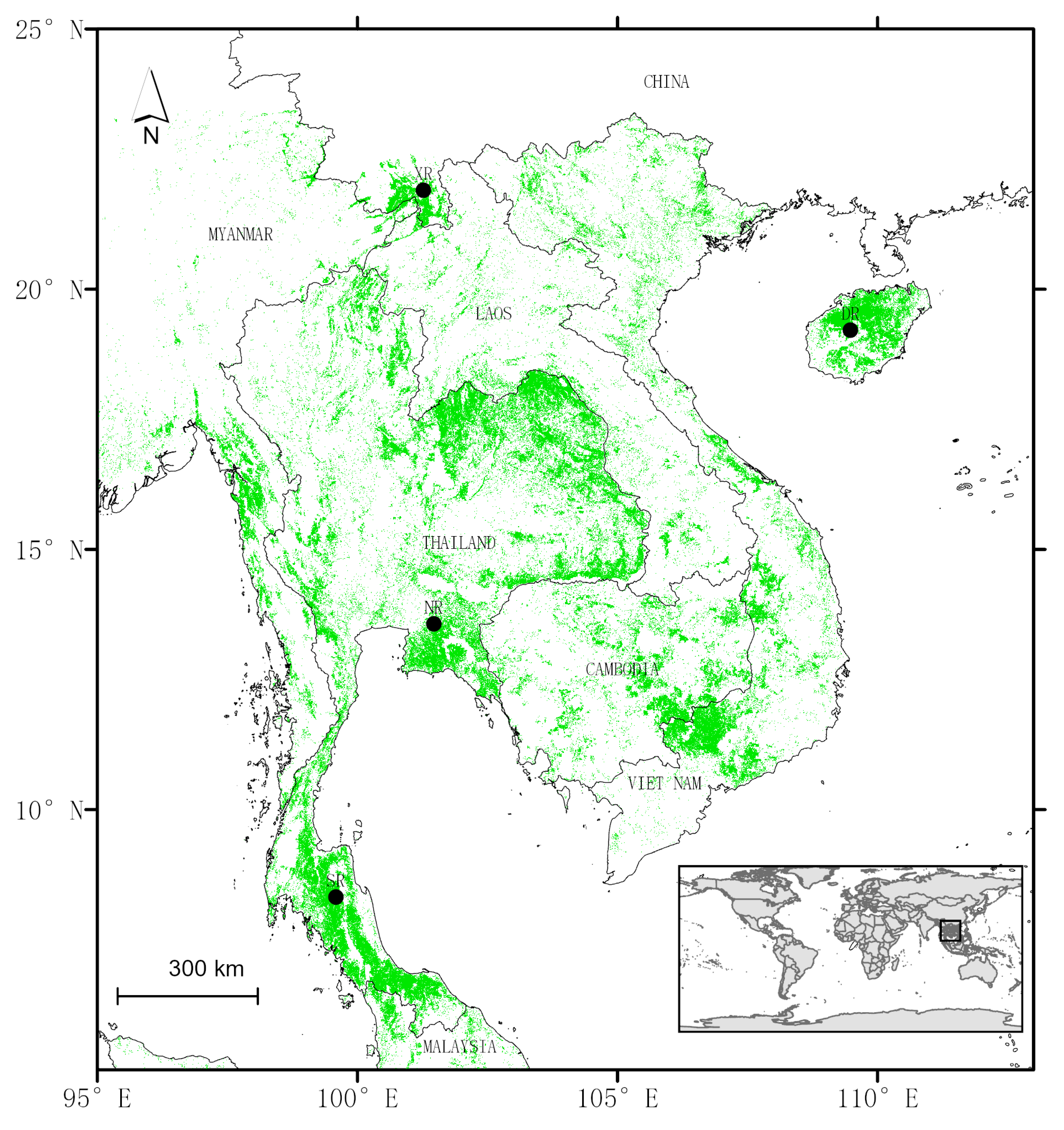

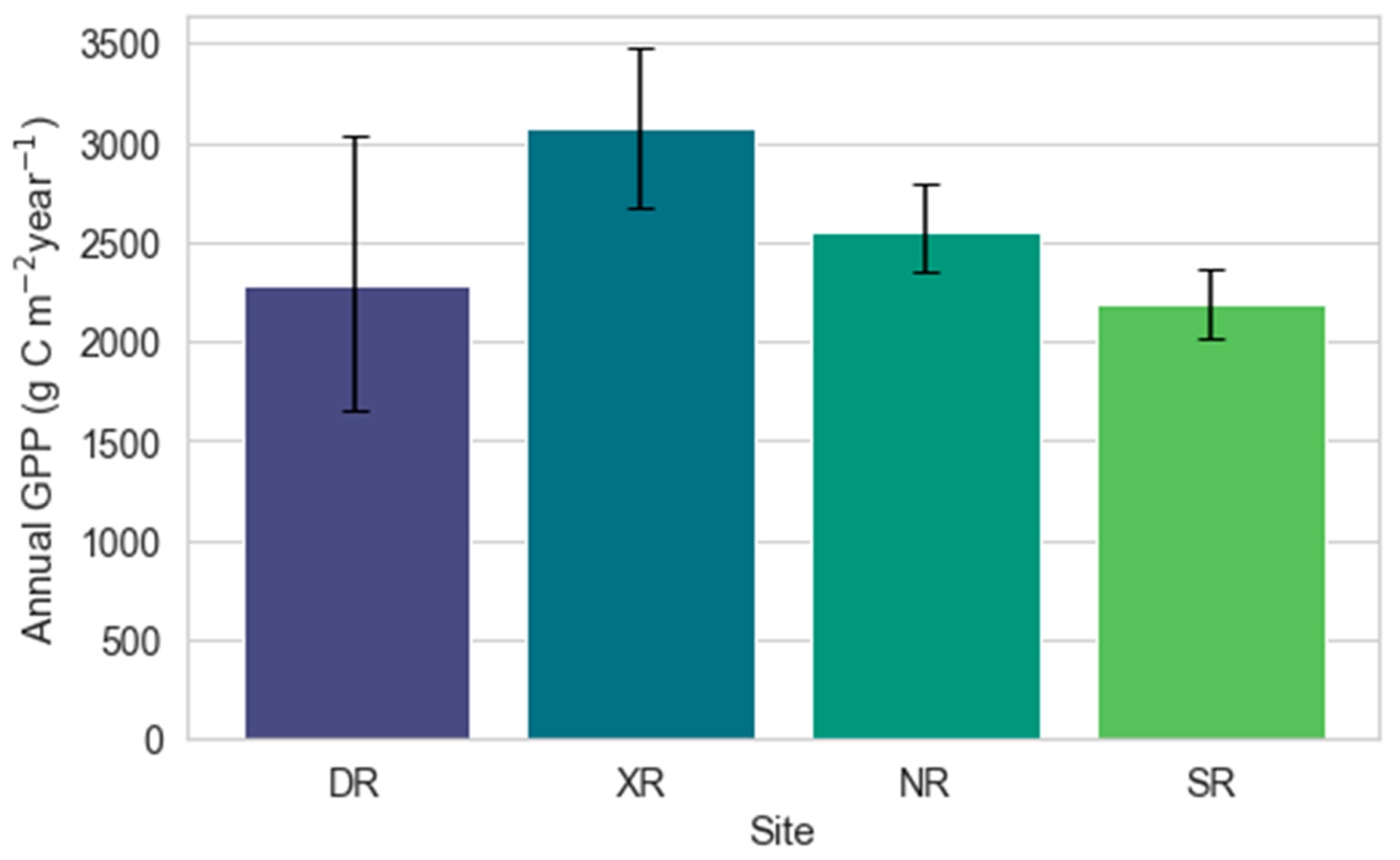

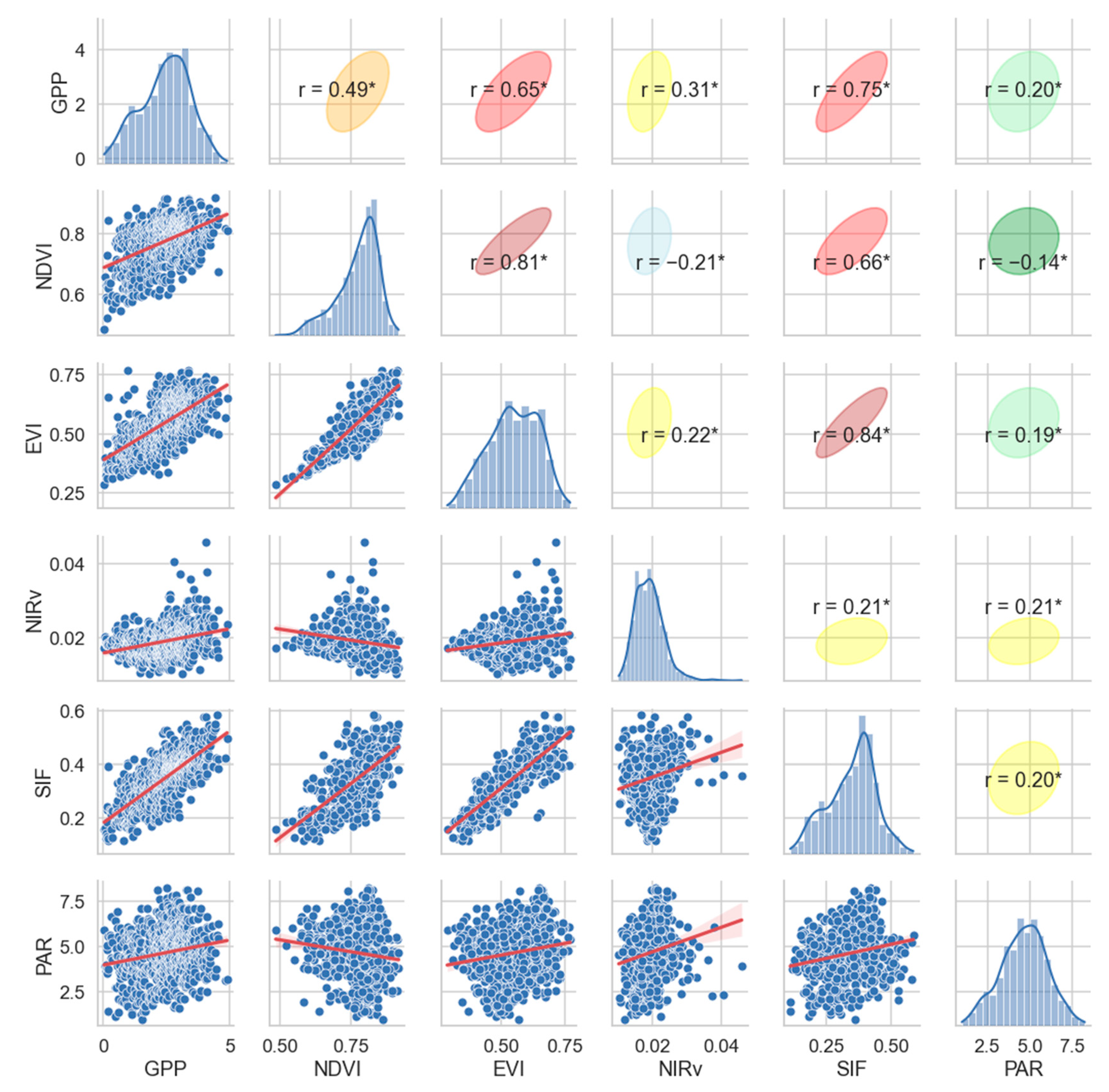

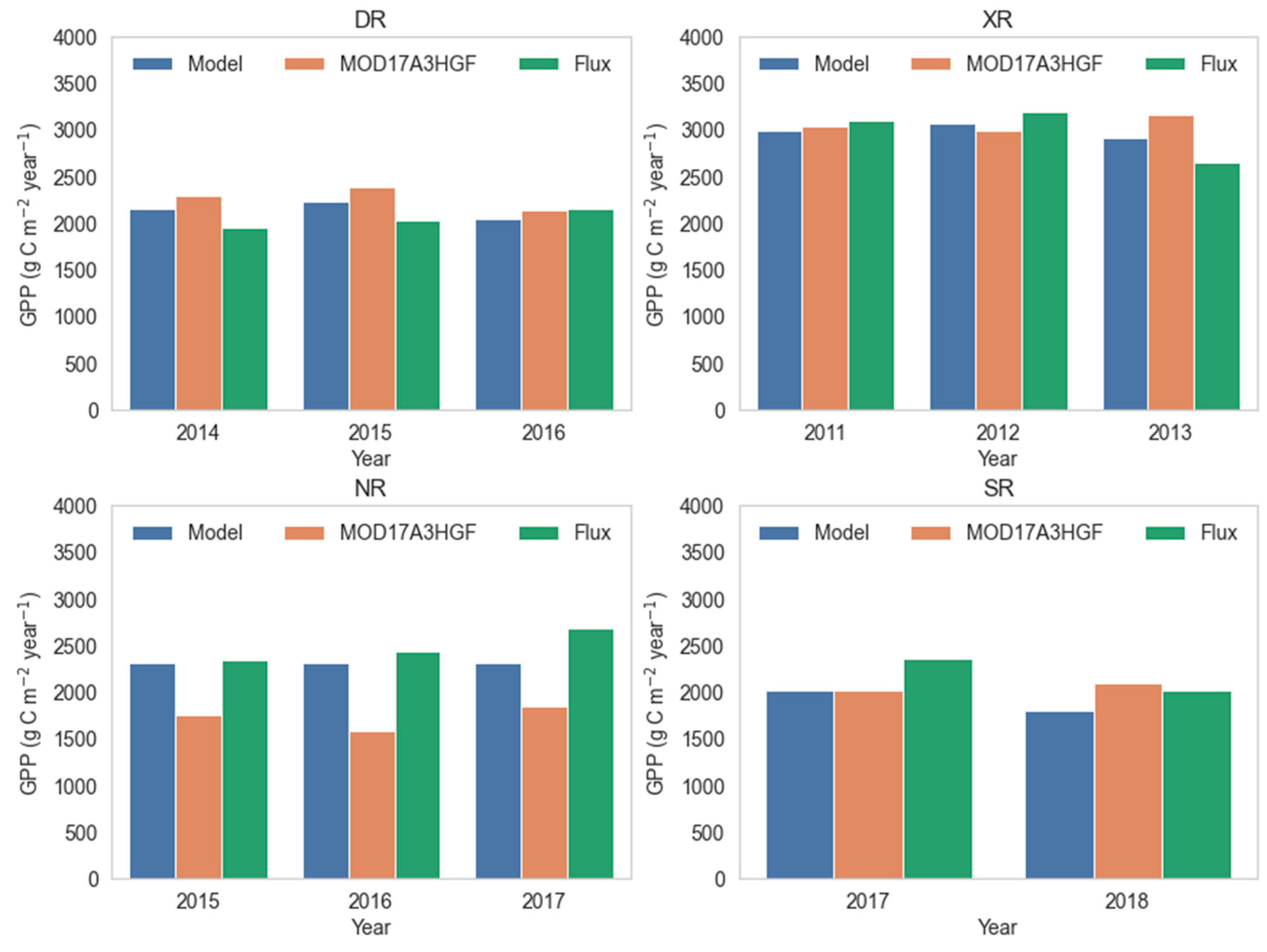

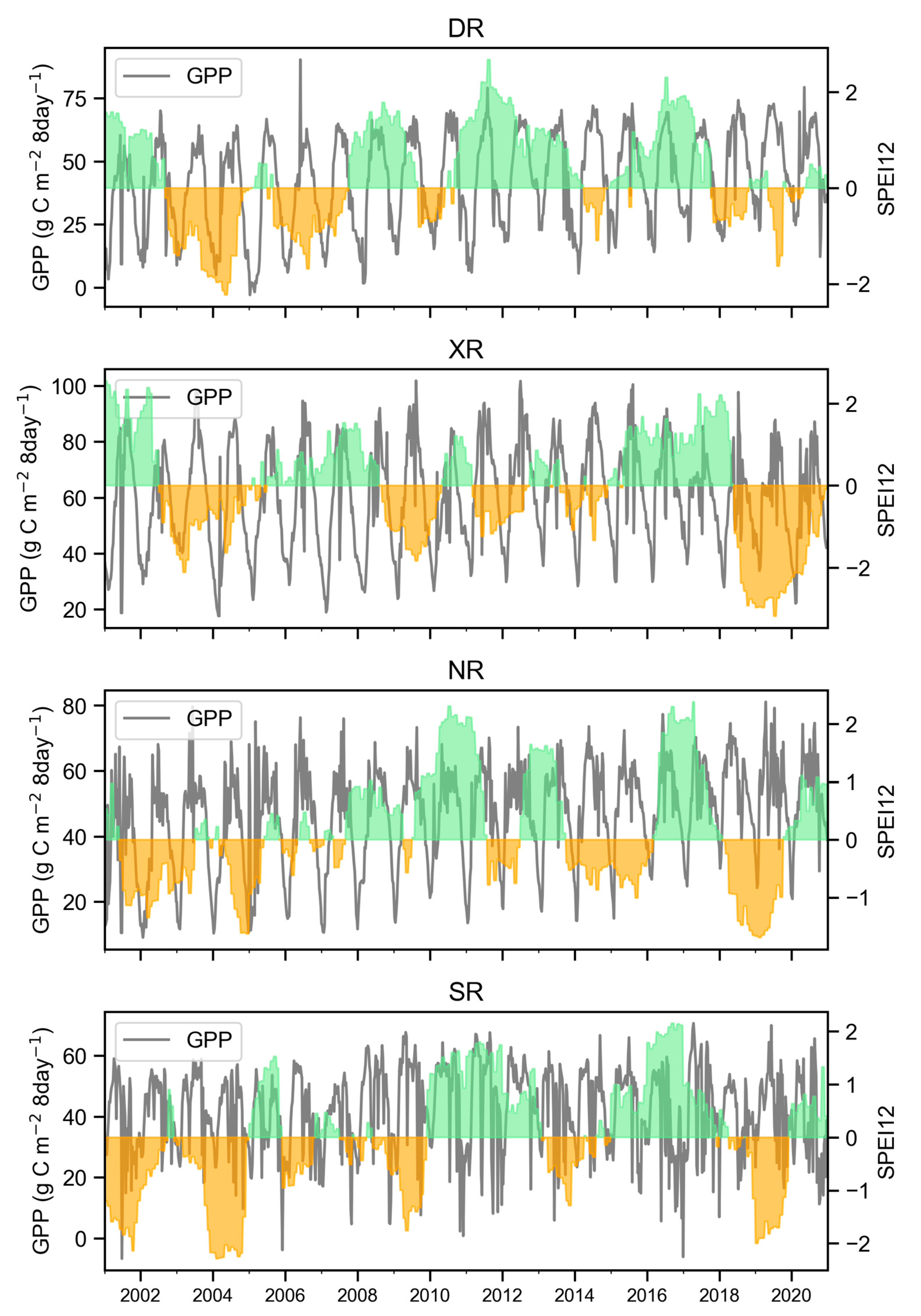


| Nation | Thailand | Thailand | China | China |
|---|---|---|---|---|
| Site Name | NR | SR | DR | XR |
| Location | 101.47° E, 13.57° N | 99.58° E, 8.32° N | 109.48° E, 19.21° N | 101.27° E, 21.90° N |
| Elevation | 69 m | 200 m | 144 m | 592 m |
| Observation Timespan | 2015–2018 | 2017–2018 | 2010–2018 | 2010–2014 |
| NDVI | EVI | NIRv | SIF | PAR | |
|---|---|---|---|---|---|
| NDVI | 0.24 | ||||
| EVI | 0.50 | 0.45 | |||
| NIRv | 0.44 | 0.52 | 0.12 | ||
| SIF | 0.62 | 0.61 | 0.61 | 0.56 | |
| PAR | 0.39 | 0.51 | 0.20 | 0.60 | 0.05 |
| DR | XR | NR | SR | |||||||||
|---|---|---|---|---|---|---|---|---|---|---|---|---|
| Rainy | Cool Dry | Warm Dry | Rainy | Cool Dry | Warm Dry | Rainy | Cool Dry | Warm Dry | Rainy | Cool Dry | Warm Dry | |
| SPEI03 < −1 | 0% | −22% | −4% | 1% | −10% | 5% | −2% | −10% | −14% | 5% | 2% | −5% |
| SPEI03 ≥ −1 | 0% | −1% | 1% | 0% | 3% | −1% | 0% | 0% | 1% | −1% | −1% | 2% |
| SPEI12 < −1 | 0% | −29% | −29% | −3% | −11% | −14% | 0% | −14% | −12% | 0% | 5% | −6% |
| SPEI12 ≥ −1 | −1% | −1% | 2% | 1% | 3% | 2% | −1% | −2% | 1% | 1% | −2% | 1% |
Disclaimer/Publisher’s Note: The statements, opinions and data contained in all publications are solely those of the individual author(s) and contributor(s) and not of MDPI and/or the editor(s). MDPI and/or the editor(s) disclaim responsibility for any injury to people or property resulting from any ideas, methods, instructions or products referred to in the content. |
© 2024 by the authors. Licensee MDPI, Basel, Switzerland. This article is an open access article distributed under the terms and conditions of the Creative Commons Attribution (CC BY) license (https://creativecommons.org/licenses/by/4.0/).
Share and Cite
Li, W.; Hou, M.; Liu, S.; Zhang, J.; Zou, H.; Chen, X.; Bai, R.; Lv, R.; Hou, W. Assessing Drought Impacts on Gross Primary Productivity of Rubber Plantations Using Flux Observations and Remote Sensing in China and Thailand. Forests 2024, 15, 1732. https://doi.org/10.3390/f15101732
Li W, Hou M, Liu S, Zhang J, Zou H, Chen X, Bai R, Lv R, Hou W. Assessing Drought Impacts on Gross Primary Productivity of Rubber Plantations Using Flux Observations and Remote Sensing in China and Thailand. Forests. 2024; 15(10):1732. https://doi.org/10.3390/f15101732
Chicago/Turabian StyleLi, Weiguang, Meiting Hou, Shaojun Liu, Jinghong Zhang, Haiping Zou, Xiaomin Chen, Rui Bai, Run Lv, and Wei Hou. 2024. "Assessing Drought Impacts on Gross Primary Productivity of Rubber Plantations Using Flux Observations and Remote Sensing in China and Thailand" Forests 15, no. 10: 1732. https://doi.org/10.3390/f15101732






